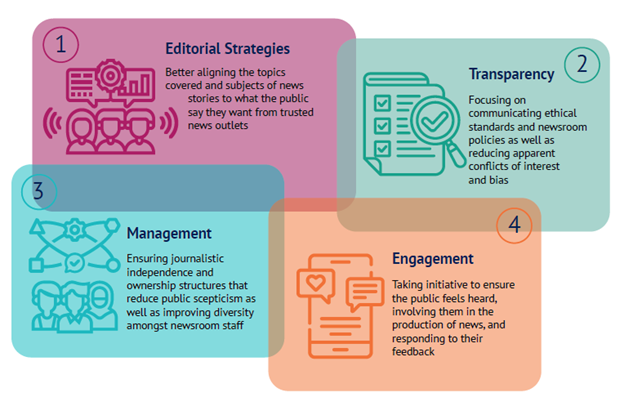What happened to trust in the news?
Studies show that readers’ trust in published news content is falling in almost every part of the world, with potentially damaging social and political implications. What are the reasons for this and what can be done about it?
Trust in news media is waning worldwide, with significant social and political repercussions. Defining trust in the media and understanding the factors at play are integral to working towards a possible solution. In this article, we explore the causes, consequences, and possible solutions to the declining trust in news media.
The two dimensions of trust
People relate to news media in two ways: firstly as consumers of news and secondly as the subject of news reporting. Trust is involved in both kinds of relationship.
As consumers, our trust depends on being able to believe the reporting we read and view. As subjects, we need to feel that our social group is fairly represented by news media. Both forms of trust are important and studies show that both are in decline.
Understanding the concept of trust in news media
It would be easy to dismiss faltering trust in the news as a problem created entirely by social media bubbles, pink slime sites, and the ever-more fragmented media landscape. However, it’s not that simple. For many communities, the credibility, reliability, and authenticity of news organizations are questionable at best.
Starting at ground level, we find that even defining trust is problematic. As Forbes recently reported, “If there is one word most misunderstood, not clearly defined, and yet overused in our worry-laden discourse about the free press and democracy, it is trust.”
What do we mean exactly by 'trust'?
They ultimately turned to a paper that is nearly three decades old for a definition:
- “‘The willingness of a party to be vulnerable to the actions of another party based on the expectation that the other will perform a particular action important to the trustor, irrespective of the ability to monitor or control that other party.’”
This definition raises an important question: What has the media done to earn trust, especially in the second sense we identified above, among vulnerable or marginalized groups with more to lose? Increasingly, the answer is, “Not enough.” This impression has contributed towards the the growing rift between news organizations and audiences.
Decline of trust: analyzing the global trend
Four years ago, according to the Reuters Institute’s Digital News Report 2020, just 38% of people across 40 markets say they typically trust most news. Even then, the problem seemed nebulous: “There is no single ‘trust in news’ problem, but rather multiple challenges involving both the supply of news and demand for information.”
Preferences about the types of journalism people prefer are as varied as the audiences themselves: “Studies have shown, for example, that some consumers find watchdog journalism off-putting or harmful to their communities (Meyer 1988; Poindexter et al. 2006) even as journalists often see it as indispensable. Some demand news that is inclusive of diverse voices (Schmidt et al. 2019) while others prefer news that supports a particular ideological worldview (Schulz et al. 2020).”
Importantly, the problem appears to be global. Reuters reported that trust had fallen by double-digit margins in places like Brazil and the United Kingdom, but even in countries with “more stable overall trends conceal stark and growing partisan divides.”
Just two years later, in 2022, Pew Research found that “half of 18- to 29-year-olds in the United States say they have some or a lot of trust in the information they get from social media sites, just under the 56% who say the same about information from national news organizations, but somewhat below the 62% who say so about information from local news organizations.”
As you might imagine, people often divide along political and other demographic lines regarding trust in the media.
Let’s examine those numbers.
Demographics of distrust: who trusts news the least and the most?
As the Pew research team dove deeper into the demographic divide, they found some interesting differences among the major parties in the U.S. Of those who lean Democratic, 77% said they have at least some trust in national news outlets, but just 42% of Republicans said the same thing. Interestingly, Pew reported, “This aligns with previous Center research showing that party is the strongest factor in the public’s broader attitudes toward the news media.”
Of course, this is not the only factor influencing how people feel about news. As Pew’s 2022 research showed, younger audiences turn to social media more. “The share of adults under 30 who express at least some trust in information from social media is at its highest level (tied with summer 2019), while the share with trust in national news is at its lowest level (tied with last year),” found Pew. This group had the smallest gap between those who trust social media sites and those who trust national news outlets. It’s not a surprise that digital natives may be more open to trusting information they get on social media - but something that may be surprising is what seems to be an overarching trust in local news.
Local vs. national news: a comparative trust analysis
While national news outlets struggle with building trust, local newsrooms seem to inspire more faith. At the local level, the gap between political parties narrows.
According to Pew, “Democrats are 16 points more likely than Republicans to have at least some trust in the information they get from local news outlets (79% vs. 63%) and 11 points more likely to say the same about social media sites (38% vs. 27%).” More recently, Pew research confirmed that local news may just be the one source of information most people can agree on: “Majorities of both major parties [in the U.S.] say local media in their area are doing their jobs well.”
In 2022, the Knight Foundation’s “Trust, Media, and Democracy” report found that “Fifty percent of Americans feel most national news organizations intend to mislead, misinform or persuade the public.” At the local level, however, Knight’s research found, “Forty-four percent of Americans say local news organizations do not intend to mislead, misinform or persuade the public.” Knight’s research also unraveled the consequences of low trust in the news, including lack of confidence in election results and a belief that “the people who really ‘run’ the country are unknown to the voters.”
Still, there is a certain logical sense to this divide. Local newsrooms are often made up of members of the community and report on issues that do not have the same partisan politics at the heart of what they do.
So, how can the nationwide sector inspire this same confidence?
Building trust: what news consumers want

(Source: Reuters)
Understanding why consumers distrust news content is crucial to rebuilding trust - but if the answer were simple, the problem would have already been solved.
Reuters has identified a four-pronged approach to addressing the trust problem. They suggest news outlets build more responsive editorial strategies, encourage transparency around journalistic practices, address concerns about management structures, and build engagement to ensure the public feels heard.
By addressing these key areas, national news outlets may be able to regain trust among some users. But, given the current social and political divides in the USA and elsewhere and the volume of misinformation and outright lies on the internet, the battle may be a long one.

